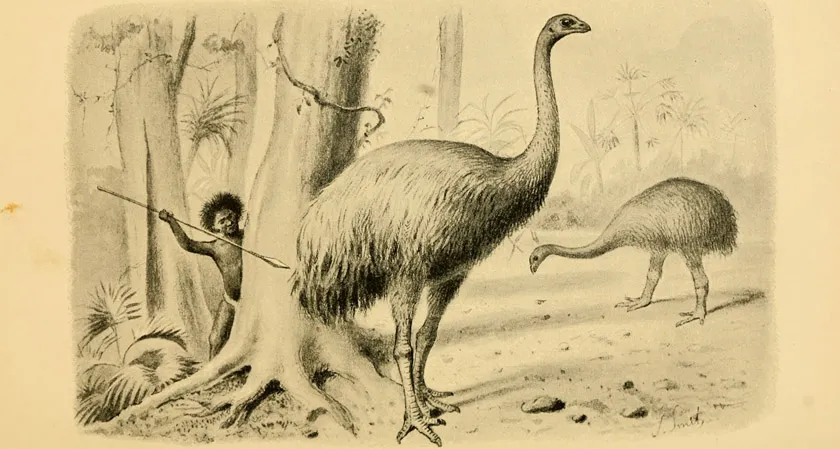Few humans were needed to wipe out New Zealand’s moa

An illustration from the 1896 book Hunting Monsters depicts a Maori hunting a tall species of moa. A new study finds that it didn’t take all that many humans to wipe out the flightless birds.
Joseph Smit/Wikimedia Commons
- More than 2 years ago
When Polynesians in the early 14th century arrived on the islands that would later be called New Zealand, they found a land rich with wildlife. That was great for the humans but not so much for several species of large, flightless birds called moa. The Polynesians’ arrival spelled their doom — within 120 years, the birds were gone.
The moa never really had a chance. These were large, long-lived species that produced few offspring, and they had no experience with a predator as efficient as a human. It didn’t take many of those human predators to wipe out the birds, it turns out. By the time the moa went extinct, the Polynesian population (known as Maori today) numbered at most 2,000 individuals, Richard Holdaway of the University of Canterbury in Christchurch, New Zealand, and colleagues reportNovember 7 in Nature Communications.
Prior to the arrival of the Polynesians, the moa populations had been thriving, Holdaway and a different set of scientists reported earlier this year in the Proceedings of the National Academy of Sciences. But what exactly happened when the humans got to New Zealand has been a bit of a mystery. In their new study, Holdaway and colleagues used a combination of archaeological, paleontological and genetic data to determine the sequence of events that led to the moa’s demise.
The eruption of Mount Tarawera on New Zealand’s North Island in 1314 left a distinct layer of ash. The earliest signs of humans — at Wairau Bar on South Island — can be found just above that layer and date to the early 14th century. Based on a genetic analysis of present-day Maori, the researchers estimate that about 400 Polynesians settled New Zealand at that time. This estimate “accords with oral traditions on the number and carrying capacity of voyaging canoes that reached New Zealand,” the researchers note.
With the knowledge that the Maori population consisted of about 100,000 people in the mid-18th century when Europeans arrived, the researchers simulated the population’s growth after the Polynesians’ arrival. They then matched that to evidence that the moa species declined and eventually disappeared within, at most, 120 years.
By 1400, the Maori population probably numbered less than 2,000 individuals, the researchers calculated, and at the height of moa hunting there were only about 1,500 people. That’s only about 1 person per 100 square kilometers (38.6 square miles) — an incredibly sparse population density. “The extinction across the entire South Island took at most five moa generations,” the researchers note, “and was substantially complete within four human generations, insufficient time for the birds to develop anti-predation strategies.”
One of the arguments against the idea that humans wiped out megafauna, such as mammoths, in the past has been that such extinctions would have required larger numbers of humans. But this study shows that may not have been necessary. “A small population of humans with a basic toolkit of stone tools and fire could… rapidly eliminate a megafauna by hunting and habitat destruction,” the researchers conclude.






